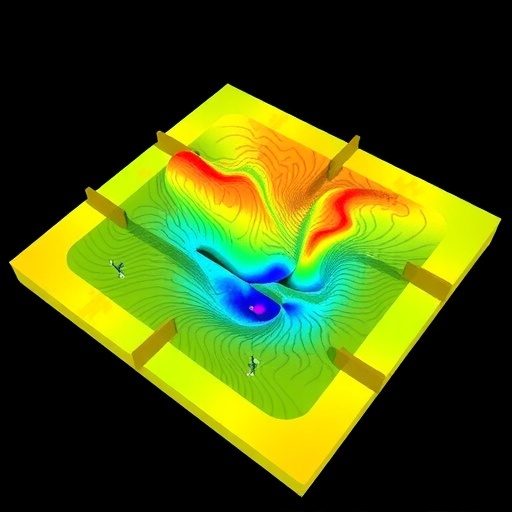In the rapidly evolving landscape of environmental science and hydrology, the accurate characterization of river basins and watershed morphology remains a crucial challenge. Traditional methods of basin morphometry—analyzing the shapes, sizes, and spatial attributes of drainage basins—have long posed difficulties due to their complexity and the vast datasets required for comprehensive assessment. However, recent advancements herald a transformative shift with the introduction of the HydroMachine toolbox, a cutting-edge software platform designed to streamline and enhance basin morphometric analysis with unprecedented precision and ease.
The HydroMachine toolbox emerges at a pivotal moment, offering researchers and environmental engineers an integrated solution to tackle the multifaceted nature of basin morphometry. This platform encapsulates a wide range of computational tools tailored specifically to process digital elevation models (DEMs), hydrological parameters, and geographic information system (GIS) data. By automating key morphometric calculations and providing an intuitive user interface, HydroMachine effectively eliminates many of the historical bottlenecks encountered when relying on manual or semi-automated techniques.
At the heart of HydroMachine’s innovation lies its ability to generate robust morphometric metrics, including basin area, perimeter, basin length, stream length, drainage density, bifurcation ratios, and relief characteristics. These parameters are essential for understanding water flow dynamics, sediment transport, and flood risk assessment within a given catchment. Traditional processes often required the piecemeal compilation of data from disparate sources followed by labor-intensive computations, but the HydroMachine toolbox consolidates these workflows, ensuring consistency and reproducibility across studies.
One of the technical marvels of HydroMachine is its sophisticated algorithmic approach to watershed delineation. Utilizing high-resolution topographic data, the toolbox accurately identifies flow accumulation paths and divides the terrain into discrete hydrological units. This multi-scale and multi-resolution capability allows for flexible analyses adaptable to a broad spectrum of basin sizes, from small sub-watersheds to expansive river networks. The precision of these delineations is critical for subsequent hydrological modeling, impacting water resource management and environmental risk assessments.
Furthermore, HydroMachine incorporates an advanced morphometric indexing system, enabling comparative analyses across basins with varied physiographic and climatic backgrounds. This IPython-based framework supports integration with open-source data repositories and other bathymetric modeling tools, augmenting its extensibility and collaborative potential. Researchers can seamlessly export results and perform sensitivity analyses, which are instrumental in evaluating the impact of land use changes and climate variability on watershed behavior.
The development team, led by a consortium of hydrologists and geomorphologists, has validated HydroMachine’s performance against established datasets and benchmarked standards. Their findings indicate that the toolbox not only improves the accuracy of morphometric parameters but also reduces the time required for comprehensive basin analysis by more than fifty percent. Such efficiency gains have profound implications for rapid environmental assessments, especially in regions vulnerable to flooding or drought conditions.
Another notable feature of HydroMachine is its capacity to handle real-time data integration. By interfacing with sensor networks and remote sensing platforms, the toolbox provides dynamic updates on basin hydrology, enabling proactive water management strategies. This functionality is particularly valuable in the context of climate change, where rapid hydrological shifts demand agile analytical tools that can inform policy and operational decisions.
In the realm of educational applications, HydroMachine also serves as a powerful pedagogical tool. Universities and research institutions can leverage its graphical user interface and comprehensive documentation to train the next generation of hydrologists in modern morphometric techniques. The open-source nature of the toolbox encourages customization and iterative improvement, fostering a vibrant community of users and developers dedicated to advancing watershed science.
Beyond its technical prowess, HydroMachine also addresses the accessibility challenges frequently faced in the environmental sciences. By lowering the barriers to entry associated with complex morphometric computations, it democratizes data analysis for practitioners in developing countries and resource-limited settings. This inclusiveness aligns with global sustainability goals, promoting equitable access to scientific tools that underpin effective natural resource management.
HydroMachine’s impact extends into applied fields such as urban planning, agriculture, and disaster mitigation. Accurate basin morphometry informs infrastructure development by elucidating flood plains and erosion hotspots, guiding the placement of resilient structures and sustainable drainage systems. In agriculture, understanding watershed characteristics supports irrigation planning and soil conservation, directly influencing food security and ecosystem health.
As the field of hydroinformatics continues to burgeon, tools like HydroMachine exemplify the integration of computational science with environmental stewardship. Its modular architecture allows for future enhancements, including machine learning-driven predictive models and enhanced visualization capabilities, ensuring that the toolbox remains at the forefront of hydrological research.
The adoption of HydroMachine by governmental agencies and international organizations signals a paradigm shift in watershed management methodologies. It empowers decision-makers with data-driven insights essential for crafting adaptive strategies in the face of increasing anthropogenic pressures and environmental uncertainties.
Importantly, the HydroMachine toolbox also fosters interdisciplinary collaboration by serving as a common platform for hydrologists, geologists, ecologists, and policy analysts. Such synergy is vital for addressing complex environmental challenges that transcend single-discipline boundaries, reinforcing the role of integrated watershed science in sustainable development.
Looking ahead, the HydroMachine development team envisions expanding the toolbox’s capabilities to incorporate climate model data assimilation and projection features. This evolution will further enhance its utility in forecasting hydrological responses to global warming scenarios, facilitating proactive adaptation measures.
In summary, the HydroMachine toolbox represents a landmark advancement in the field of basin morphometry, transforming a traditionally cumbersome task into an efficient, precise, and accessible process. Its sophisticated algorithms, user-centric design, and versatile functionalities not only accelerate hydrological research but also catalyze informed environmental management worldwide. As water-related challenges intensify globally, innovations like HydroMachine are poised to play a critical role in safeguarding our planet’s vital freshwater resources.
Subject of Research: Basin Morphometry and Watershed Analysis Using the HydroMachine Toolbox
Article Title: Basin morphometry? It is no longer an issue with HydroMachine toolbox.
Article References:
Topsakal, M., Dogan, E., Yasak, S.S. et al. Basin morphometry? It is no longer an issue with HydroMachine toolbox. Environ Earth Sci 84, 342 (2025). https://doi.org/10.1007/s12665-025-12352-8
Image Credits: AI Generated




